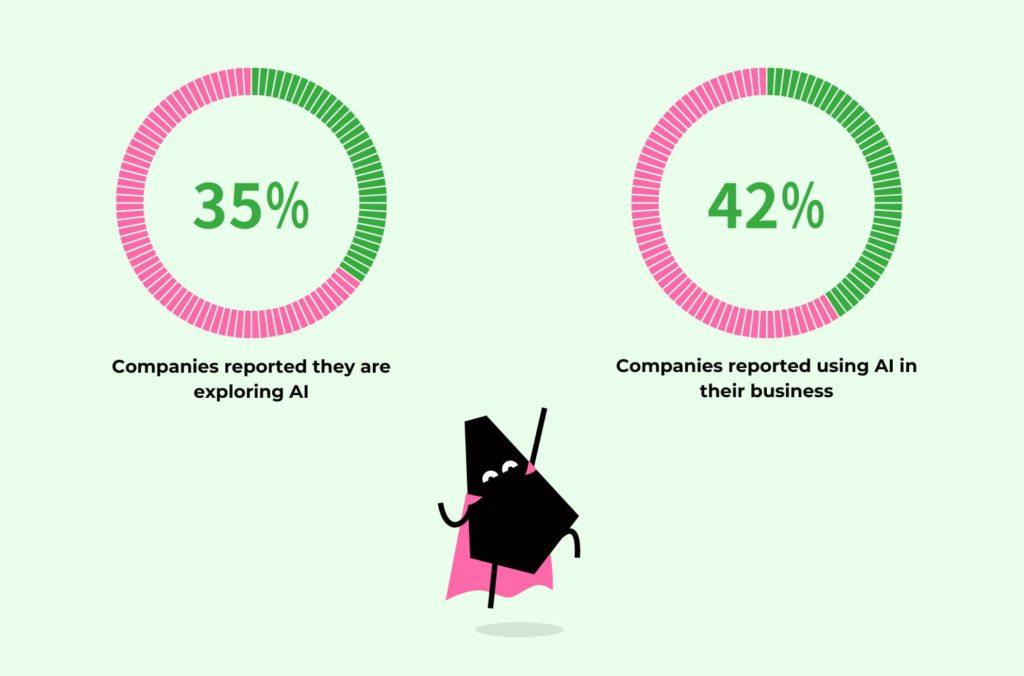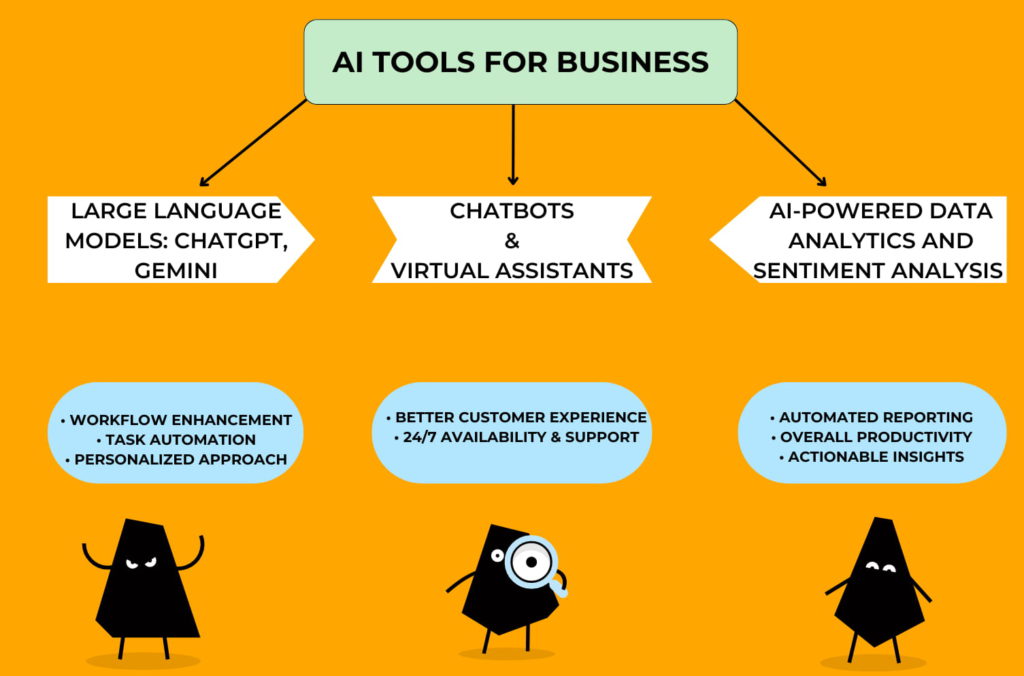Why is AI a panacea in business process automation?

Intro
Before 2010, everything we heard about AI came from movies. It was the stuff of science fiction, where robots and intelligent machines were depicted as distant possibilities or even existential threats.
AI was more of a concept than a reality, something that lived in the imaginations of futurists rather than in the boardrooms of businesses. The idea that AI could one day revolutionize industries, enhance our daily lives, and solve complex problems seemed like a far-off dream.
Then, Apple released Siri, the first popular virtual assistant. The next huge culmination was the introduction of large language models like ChatGPT and Gemini. These models showcased how AI could be harnessed to automate processes in ways ever imagined.
It is not for nothing that AI has covered most domains. A report by Statista underscores this rapid expansion.

It slammed the door wide open to the business world. Really, we interact with virtual assistants when contacting banks, telecom service, or Internet providers. Personalized recommendations are ubiquitous, from streaming platforms to online shopping. Everything is personalized with AI, even treatment in healthcare. AI algorithms are deployed to advise, detect, analyze, predict, assist, customize, service, and more.
Despite these advancements, some remain skeptical, anxious, or concerned about the security and reliability of using AI. Our goal is to clarify why developing AI infrastructure and deploying its practices is worth it and address these concerns. The rest is up to you.
Popular AI tools for business: risks and solutions
Once again back to some figures. According to a report by PWC, 42% of companies are exploring AI, and 35% are already using AI in their business. But what tools are those who benefit the most from using AI transformation? It’s time to examine the AI products most used across various industries.

Large Language Models (LLMs): ChatGPT
Large language models, such as ChatGPT, are at the forefront of AI innovation. Organizations use LLMs to automate responses to customer inquiries, create engaging output, and analyze large volumes of text data to extract meaningful insights.
LLMs advantages for business process automation
- Workflow enhancement: LLMs streamline repetitive tasks, reducing manual labor and improving efficiency.
- Customer experience: They provide personalized, instant responses to customer inquiries, improving satisfaction and engagement.
- Overall productivity: LLMs automate complex tasks, freeing up human resources for more high-value tasks.
LLMs possible risks
- Data security: Delivering sensitive data to private AI models can expose the information to potential breaches or unauthorized access, risking privacy and confidentiality.
- Credibility: Public AI models may lack the ability to verify facts in real time, leading to outdated, misleading, or incorrect information that can damage an organization’s reputation.
Best LLM solutions
Developing a local LLM: We have a success story of deploying a private LLM that operates within an organization’s own infrastructure. The point is, input data is handled internally and never leaves the company. This localized setup ensures that sensitive information is not exposed to external threats.
For details, please refer to our previous article “How to use a local ChatGPT in healthcare securely”?
Fine-tuning the model: Our team also resolved the credibility and liability issues related to the LLM. It was done by training the model on data relevant to the organization’s field, improving the model’s ability to generate accurate and client-specific responses based on bad and good answers given.
Virtual assistants and chatbots
Virtual assistants and chatbots have become integral tools in the business landscape, enhancing customer interactions and automating various service functions. Their applications vary from sales process to support, significantly helping customers at different stages of their journey.
Advantages of virtual assistants and chatbots
24/7 availability: Virtual assistants and chatbots provide round-the-clock customer support, ensuring that users can get help or information at any time. This continuous availability helps businesses cater to global audiences and address customer needs outside of regular business hours.
Cost efficiency: Implementing chatbots reduces the need for large customer service teams, cutting down on operational costs. By handling routine inquiries and tasks, these AI tools allow human agents to focus on more complex and high-value interactions.
Scalability: Virtual assistants and chatbots can easily scale to handle varying volumes of customer interactions. During peak times, such as sales or promotional events, these tools manage increased traffic without compromising service quality.
Consistency and accuracy: Chatbots provide consistent responses to customer queries, ensuring that all users receive the same level of service. This consistency reduces the likelihood of human errors and ensures accurate information delivery.
Risks associated with virtual assistants and chatbots
Customer frustration: Chatbots may struggle with understanding complex or nuanced queries, leading to customer frustration. If a chatbot cannot accurately interpret or respond to a question, it can result in poor user experience and dissatisfaction.
Security vulnerabilities: Virtual assistants and chatbots that handle sensitive information are susceptible to security threats. Data breaches or hacking attempts could expose customer data, leading to privacy concerns.
Limited flexibility: While chatbots excel at handling predefined tasks, they may struggle with unexpected or unusual requests. Their responses are based on pre-programmed logic and may lack the flexibility needed to address unique customer situations.
Best practices for virtual assistants and chatbots
In fact, the approach to overcoming these risks is the same as in the first tool. We built a local AI chatbot as a relief for administrative tasks, where we paid attention to:
AI training: We trained the chatbot with diverse and comprehensive datasets to improve its understanding and response capabilities. Plus, we integrated an appropriate knowledgebase, equipping the tool with context-aware capabilities.
Similarly, fallback mechanisms and respective algorithms can be implemented to avoid unresolved situations, ensuring a seamless customer experience.
Local setup: We privately created the chatbot in the organization’s environment so that data never goes outside and stays safe within the company.
Slack integration: For the convenience of staff, it was decided to have the tool integrated into Slack, which was a preferred communication platform. Likewise, the chatbot may be pushed to any desired environment.

AI-powered data analytics and feedback analysis tools
AI-driven analytics tools transform the way organizations gather, interpret, leverage, and react to data. By integrating artificial intelligence into analytics, businesses can gain deeper insights, make more informed decisions, and uncover patterns that were previously difficult to detect.
Meanwhile, sentiment analysis is a specialized AI-powered feedback analysis tool designed to understand and categorize emotions and opinions expressed in text. It is widely used in various domains to gauge public perception, customer satisfaction, and brand reputation.
AI data analytics and sentiment analysis tool advantages
Enhanced data interpretation: AI-powered analytics tools can analyze vast amounts of data at high speed, identifying trends, correlations, and outliers that human analysts might miss. This enhanced interpretation helps organizations make more accurate predictions and strategic decisions based on comprehensive data analysis.
Understanding customer sentiment: Sentiment analysis tools analyze customer feedback, reviews, and social media posts to determine the overall sentiment—positive, negative, or neutral. This analysis helps businesses understand how their customers feel about their products, services, and brand.
Personalized insights: By leveraging machine learning algorithms, AI-powered analytics tools can provide tailored insights specific to different segments of the business. This personalization helps in creating targeted strategies, improving customer experiences, and optimizing business operations.
Real-time monitoring: These tools can provide real-time insights into customer opinions, allowing businesses to quickly address any emerging issues or capitalize on positive trends. This timely feedback is crucial for managing brand reputation and improving customer service.
Predictive analytics: AI tools can use historical data to forecast future trends and behaviors. This capability enables businesses to anticipate market changes, customer needs, and potential risks, allowing them to proactively address challenges and capitalize on opportunities.
Automated reporting: AI analytics tools can automate the generation of reports and dashboards, providing real-time insights without the need for manual data compilation. This automation saves time and reduces the risk of errors in reporting, ensuring that decision-makers have access to up-to-date and accurate information.
Market research: By analyzing sentiment trends over time, businesses can gain valuable insights into market dynamics and customer preferences. This information is useful for adjusting marketing strategies, product development, and customer engagement approaches.
Risk mitigation: Sentiment analysis helps identify potential PR crises or customer dissatisfaction early. By detecting negative sentiments and addressing them proactively, businesses can mitigate risks and prevent damage to their brand reputation.
Possible risks associated with data analytics and feedback analysis tools
Data privacy issues: Handling sensitive or personal data for sentiment analysis can raise privacy concerns. Ensuring the protection of customer information is crucial to maintaining trust and compliance with data protection regulations.
Contextual misinterpretation: Sentiment analysis tools might struggle with understanding the context or nuance of certain statements, leading to incorrect sentiment categorization. For example, sarcasm or idiomatic expressions may be misinterpreted.
Solution for AI data analytics and analysis tools
Private deployment: We have built our own sentiment analysis product within a safe infrastructure, where data is handled securely.
AI training: In addition to adding features like service categorization, auto-response generation, alerts, etc., our team improved the tool’s algorithms by incorporating diverse datasets and context-aware models. The sentiment analysis model was also set to deliver accuracy in detecting and interpreting various contexts.
For details, check out our case study related to developing a sentiment analysis tool.
Conclusion: AI business automation is more than a reality now
AI is not just a tool for business process automation; it is a driving force shaping the future of modern enterprises. By automating repetitive tasks, enhancing customer experiences, and providing deep analytical insights, AI enables businesses to operate more efficiently and strategically.
Here is the thing: to implement it smoothly, it is required to start your own AI infrastructure, have an in-house AI engineering department, and integrate AI practices to take a lead on this path before competitors do. All we can say is, at this stage, AI itself will not make a difference, but people equipped with AI will.
Open up AI access to empower your business





